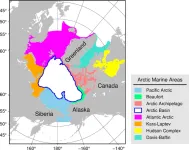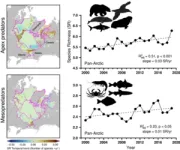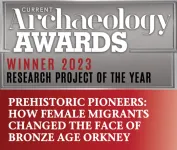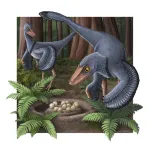(Press-News.org) Marine predators have expanded their ranges into the Arctic waters over the last twenty years, driven by climate change and associated increases in productivity.
The seas surrounding the Arctic are important fisheries and ecological regions; they are also among the areas most affected by climate change. The effects of warming waters and loss of sea ice on the biodiversity of these waters, and hence their ecology, is still not fully understood.
An international team of researchers led by Dr. Irene D. Alabia at the Arctic Research Center at Hokkaido University has examined Arctic-wide and regional changes in species richness, composition, and potential species associations. Their findings, published in the journal Scientific Reports, show that recent changes in biodiversity were driven by pervasive poleward species range expansions.
“We used data on the occurrences of 69 species of apex predators and mesopredators in eight Arctic areas from 2000–2019,” Alabia explains. “We combined this information with climate and productivity data across the same period to map species-specific habitat distributions.”
The team calculated the species richness, community composition, and co-occurrences between species pairs throughout the twenty-year study period at each of the eight Arctic areas. They were able to infer potential species associations and changes therein from the co-occurrence data.
Their most important finding was that species richness—the number of different species represented in the study regions—has increased over the study period, driven by the northward migration of apex predators such as whales, sharks and seabirds. Mesopredators such as fish and crabs exhibited a relatively limited degree of northward migration, confined to the shallow continental shelf seas of the Pacific and Atlantic. Although the spatial extent varies, this northward expansion was driven by changes in either climate, productivity, or both.
These climate-driven biodiversity changes, in turn, led to alterations in potential species associations due to habitat overlap between taxa from different marine communities during unprecedented periods of temperature and sea ice changes.
“Our findings revealed that changes in climate and species richness in the Arctic vary across different large marine areas and highlight potential regions of climate and productivity hotspots, and emerging areas of species gain,” Alabia concluded. “This information is relevant for strengthening conservation and management efforts for the sustainable use of resources under the expanding footprints of climate change in the Arctic.”
END
Warming Arctic draws marine predators northwards
2023-04-04
ELSE PRESS RELEASES FROM THIS DATE:
New low-cost camera could help scientists forecast volcano eruptions affecting millions
2023-04-04
Gas emissions are the manifestation of activity occurring beneath the surface of a volcano. Measuring them lets researchers see what can’t be seen from the surface. This knowledge is vital for hazard monitoring and the prediction of future eruptions. Since the mid-2000s, ultraviolet SO2 cameras have become important tools to measure emissions. The measurement campaigns, however, must be accompanied by a user, making SO2 cameras unsuitable for acquiring long-term datasets. Building and operating this type of camera can cost upwards ...
Personal finances increasingly play second fiddle to personality, finds lonely hearts ad study
2023-04-04
Personality has become a more important factor than finances when it comes to dating, a new study has found.
Researchers from the University of York and the University of Essex analysed more than a million lonely hearts ads and found that in the USA, France, and Canada, there was a sharp decline in economic factors when choosing a partner. However, finances remained an important issue in India when it came to relationships.
To see how partner preferences changed over time, the researchers analysed lonely hearts ads from various major news outlets from Canada, France, and India. They collected data from publications from 1950 to 1995, the year that most of these ads shifted to being online. ...
Double-anonymous peer review reduces reviewer bias, finds three-year trial
2023-04-04
Today (4 April) the British Ecological Society has published the results of a three-year randomised trial comparing double and single-anonymous peer review in the journal Functional Ecology. The findings indicate a reduction in reviewer bias when author identities are anonymised.
The three-year randomised trial in the journal Functional Ecology, provides the most compressive data yet on the effects of anonymising authors during scholarly journal peer review.
Double-anonymous peer review, also referred to as double-blind peer review, is where author identities are not disclosed to reviewers. This differs from single-anonymous peer review where reviewers know ...
Study finds harmful PFAs don’t actually prevent furniture stains
2023-04-04
The health and environmental harms of per- and polyfluoroalkyl substances (PFAS) are well-known, but a new peer-reviewed study calls into question their touted stain-fighting benefits. The study, published today in the AATCC Journal of Research, tested the performance of PFAS finishings on furniture fabrics and found that they had limited to no effectiveness, particularly under real-world conditions.
“It was surprising that these harmful but supposedly indispensable chemicals had no practical benefit,” said lead author Jonas LaPier, a PhD ...
Scientists call for coordinated global effort to assess the full environmental impacts of tritium
2023-04-04
Scientists have called for a coordinated international effort to fully assess the environmental impacts of tritium ahead of a significant expected rise in its global production.
A radioactive isotope of hydrogen, tritium is a by-product of the nuclear industry and its presence is predicted to grow exponentially with nuclear increasingly seen as being key to the global low carbon economy.
That will result in many nations having to develop long-term strategies to manage tritiated radioactive waste and develop tools to both assess and address its environmental impact.
However, writing in the journal Science of the Total Environment, ...
Study highlighting female-led migration into Bronze Age Orkney wins Current Archaeology’s prestigious Research Project of the Year award for 2023
2023-04-03
A revolutionary investigation that shed vivid light on pioneering female migrants who made their way to Orkney during the Bronze Age has won Research Project of the Year at the prestigious Current Archaeology Awards for 2023.
The project – a collaboration between EASE Archaeology and the University of Huddersfield – focused on human remains excavated at the Links of Noltland, a Bronze Age cemetery on the island of Westray. This work revealed the first concrete evidence of a major influx of non-local people into Orkney during the Bronze Age – and, significantly, it appears that this migration ...
Origami-inspired robots can sense, analyze and act in challenging environments
2023-04-03
Roboticists have been using a technique similar to the ancient art of paper folding to develop autonomous machines out of thin, flexible sheets. These lightweight robots are simpler and cheaper to make and more compact for easier storage and transport.
However, the rigid computer chips traditionally needed to enable advanced robot capabilities — sensing, analyzing and responding to the environment — add extra weight to the thin sheet materials and makes them harder to fold. The semiconductor-based components therefore have to be added ...
Analysis of dinosaur eggshells: bird-like Troodon laid 4 to 6 eggs in a communal nest
2023-04-03
FRANKFURT. In millions of years and with a long sequence of small changes, evolution has shaped a particular group of dinosaurs, the theropods, into the birds we watch fly around the planet today. In fact, birds are the only descendants of dinosaurs which survived the catastrophic extinction 66 million years ago that ended the Cretaceous period.
Troodon was such a theropod. The carnivorous dinosaur was about two meters long and populated the vast semi-arid landscapes of North America about 75 million years ago. Like some of its dinosaur relatives, Troodon presented some bird-like ...
Remember me? Gender, race may make you forgettable
2023-04-03
ITHACA, N.Y. - At an academic conference some years ago, Michèle Belot remembers talking with a participant who was convinced she had authored a research paper that wasn’t hers. He’d confused her with another female scholar, an experience she said is familiar to many colleagues.
Such incidents – plus awareness of her own imperfect memory – inspired Belot, a professor in the Department of Economics at Cornell University, to investigate systemic biases in the way we remember people, since this could influence social networks important to career advancement.
In new research focused on academia, Belot ...
Non-invasive brain stimulation can regulate autonomic responses and improve oxygen saturation in hospitalized patients with Covid-19
2023-04-03
Among the health problems developed or aggravated by Covid-19, those that affect neurological and respiratory functions draw special attention from specialists. Considering several studies that show the adverse effects of Covid-19 on human autonomic functions, which are those regulated by the Autonomic Nervous System (ANS), a recent Brazilian study has demonstrated that the use of non-invasive brain stimulation was capable of regulating the ANS and increasing the oxygen saturation in patients with Covid-19 admitted to a semi-intensive ...






